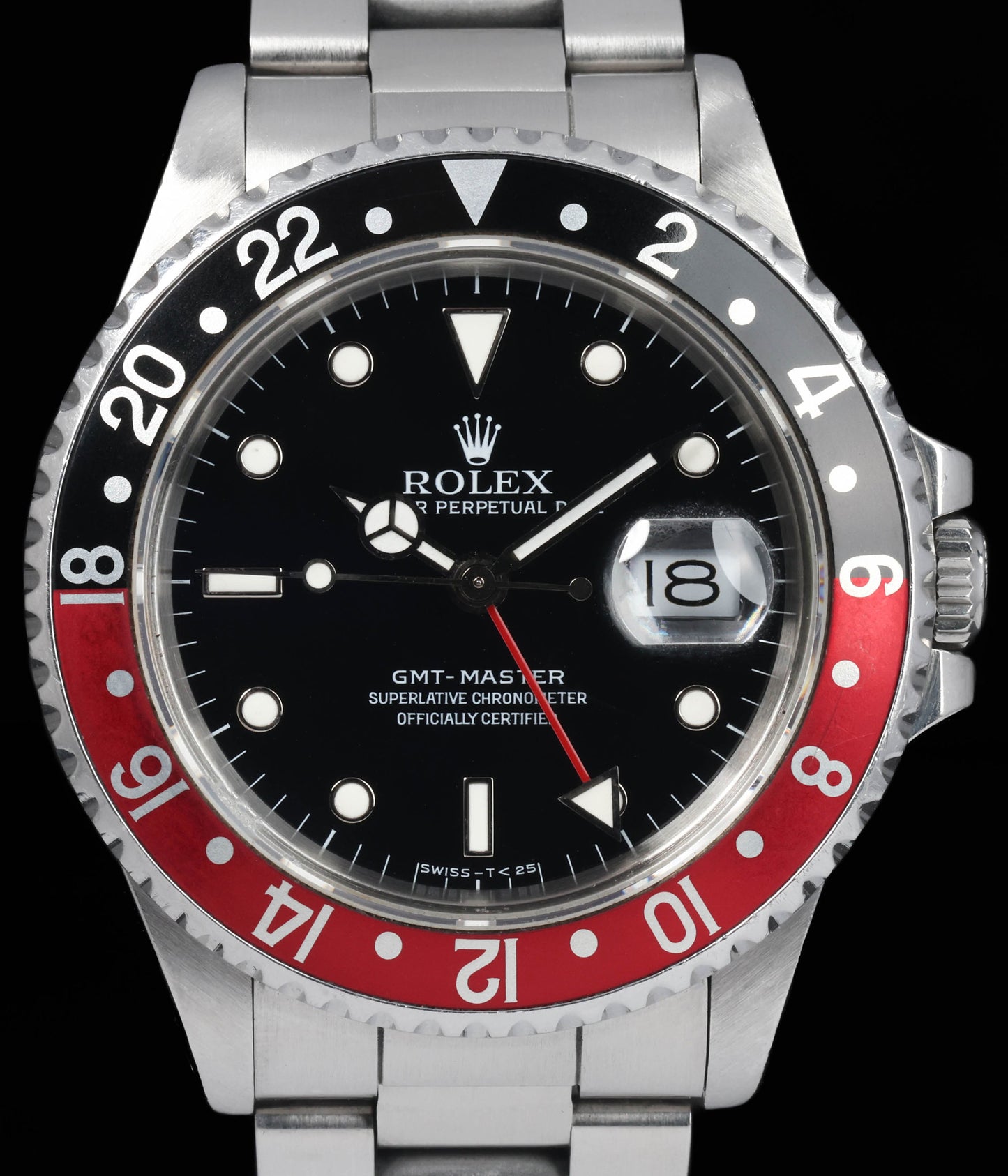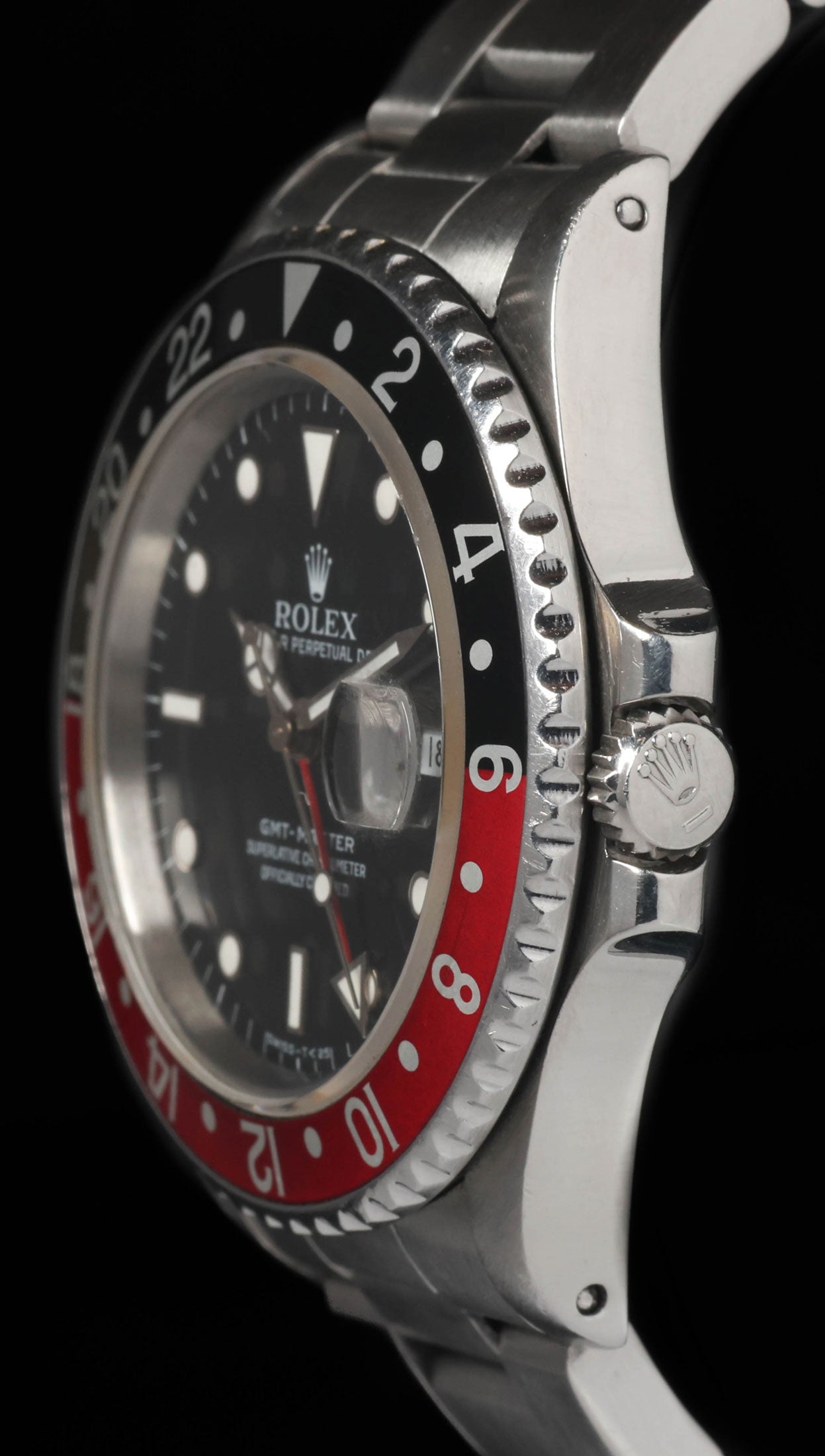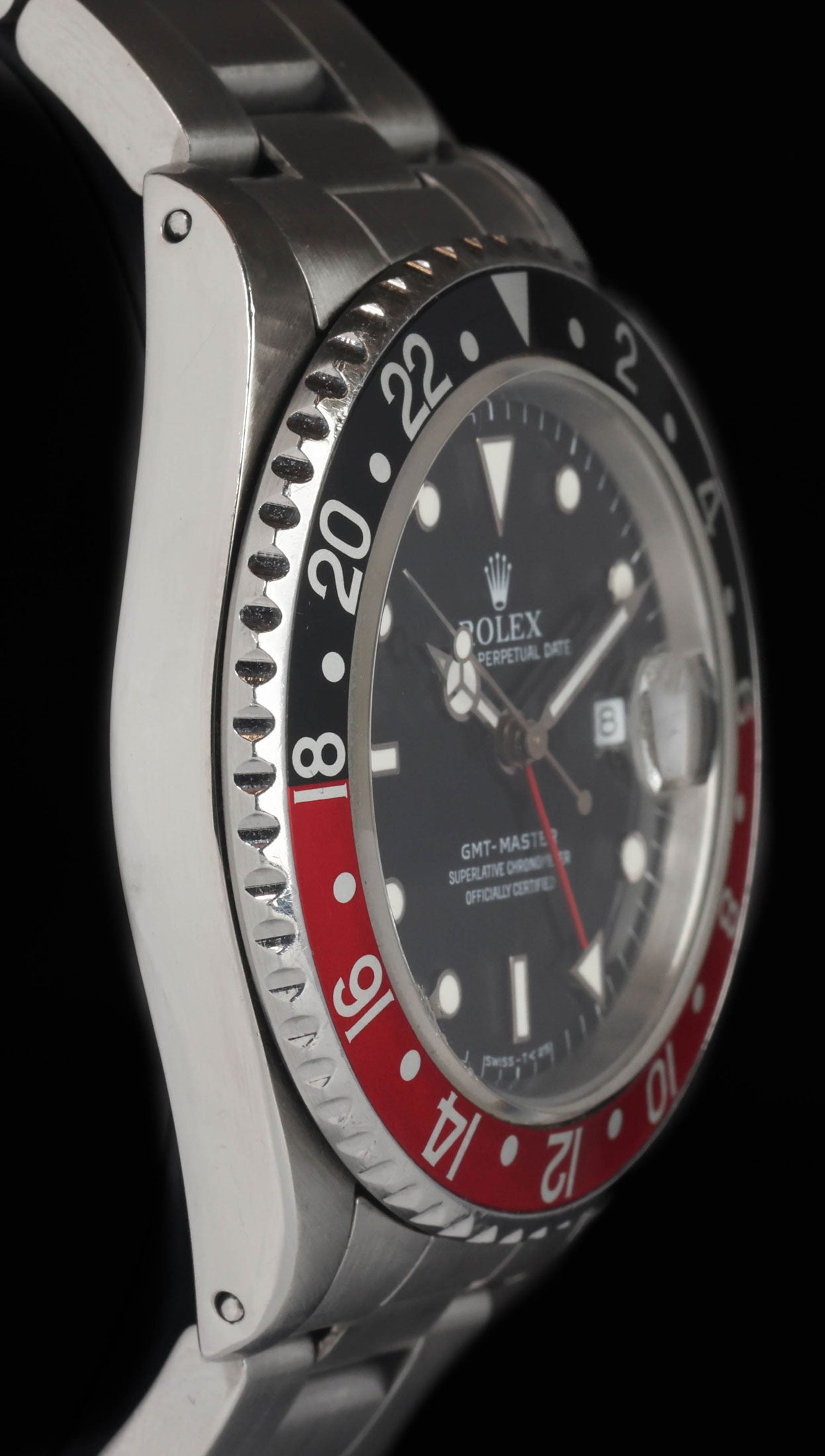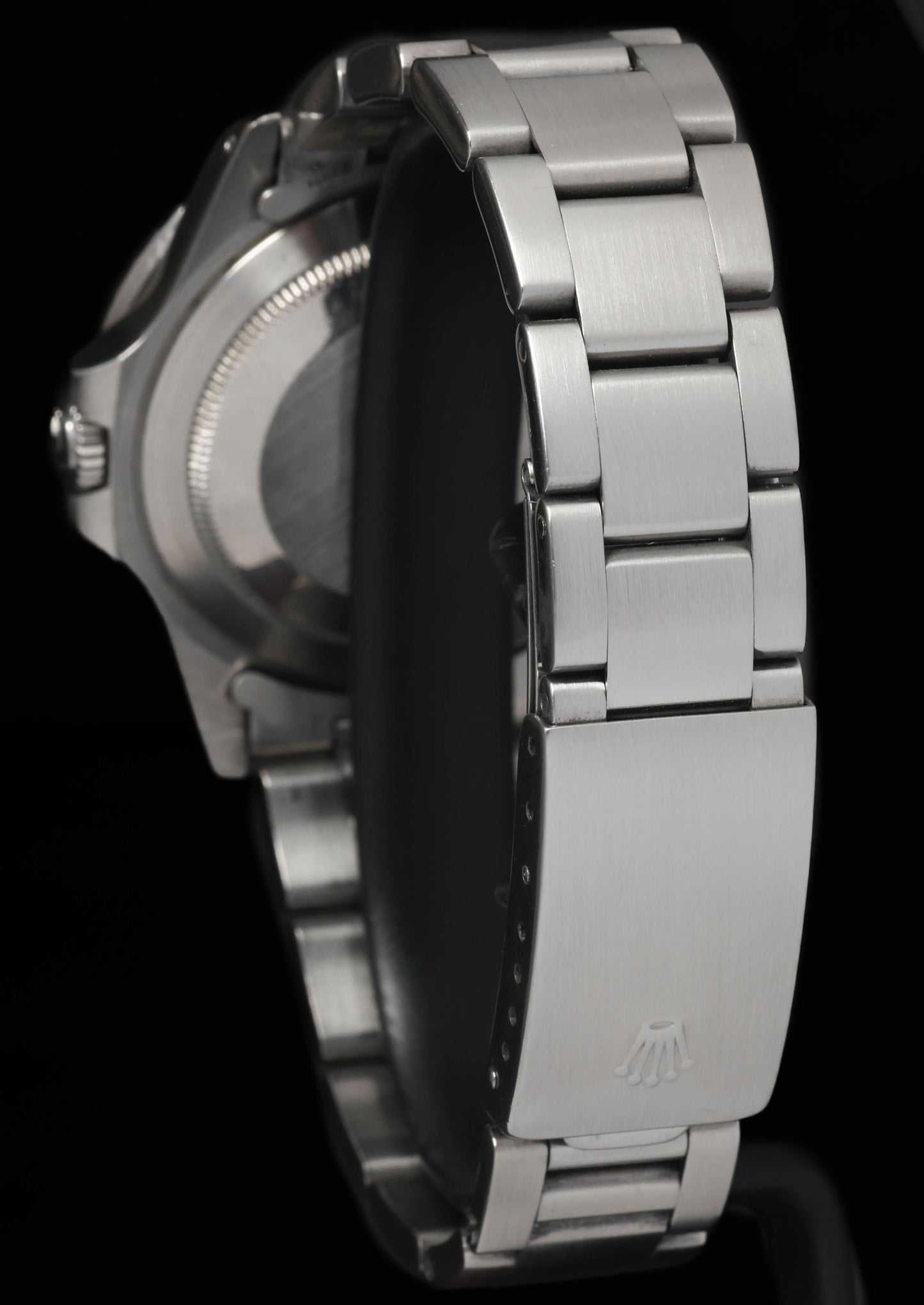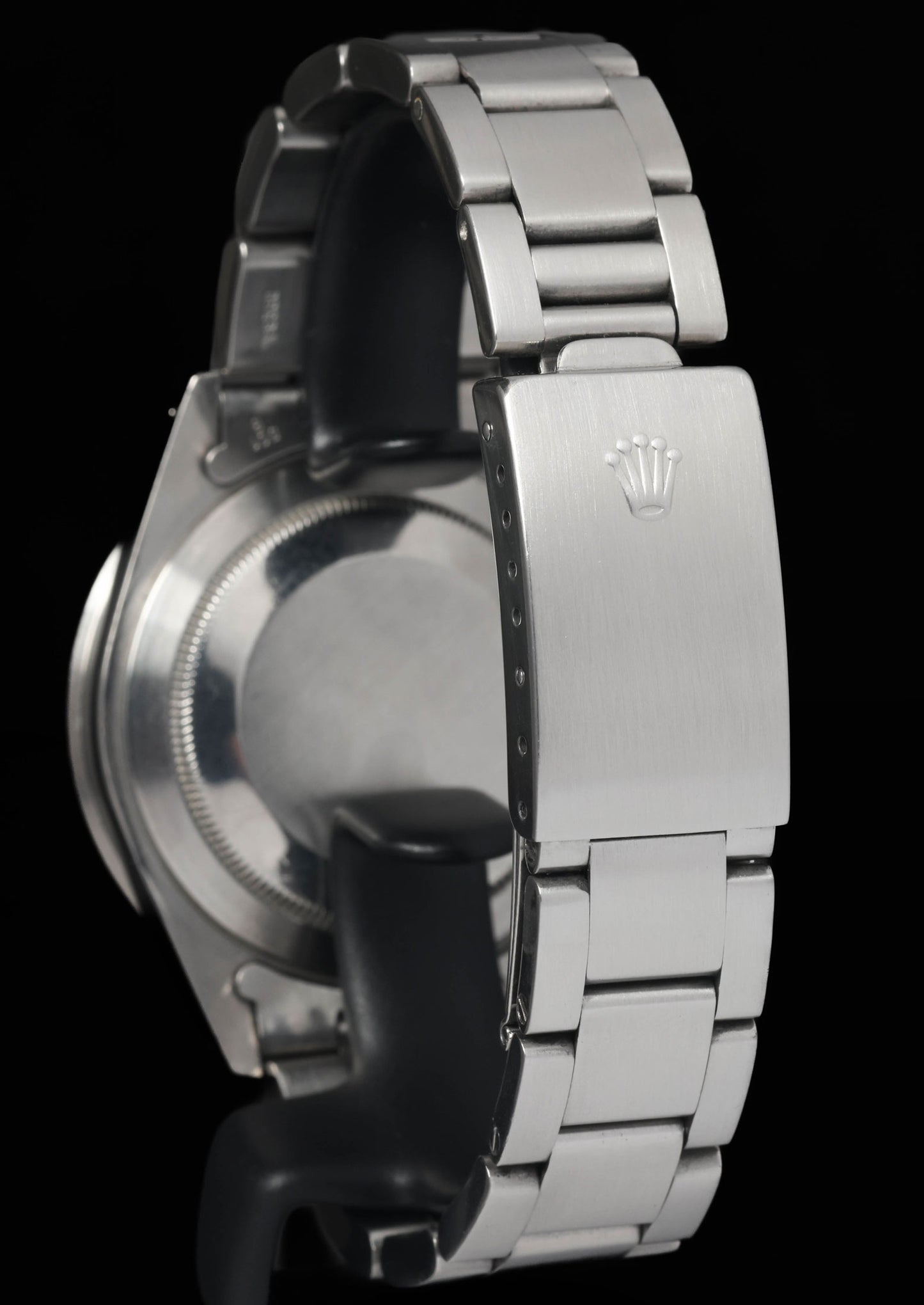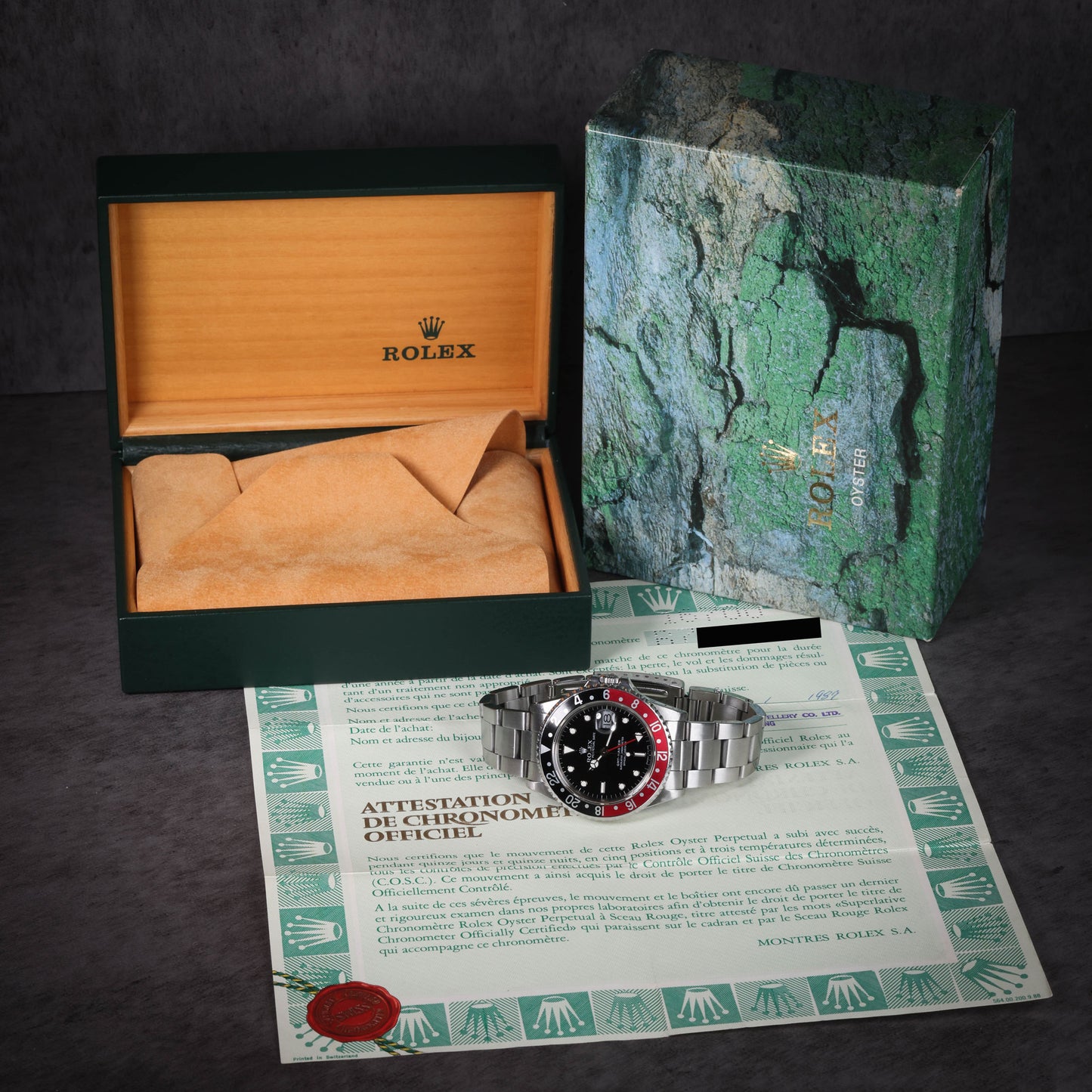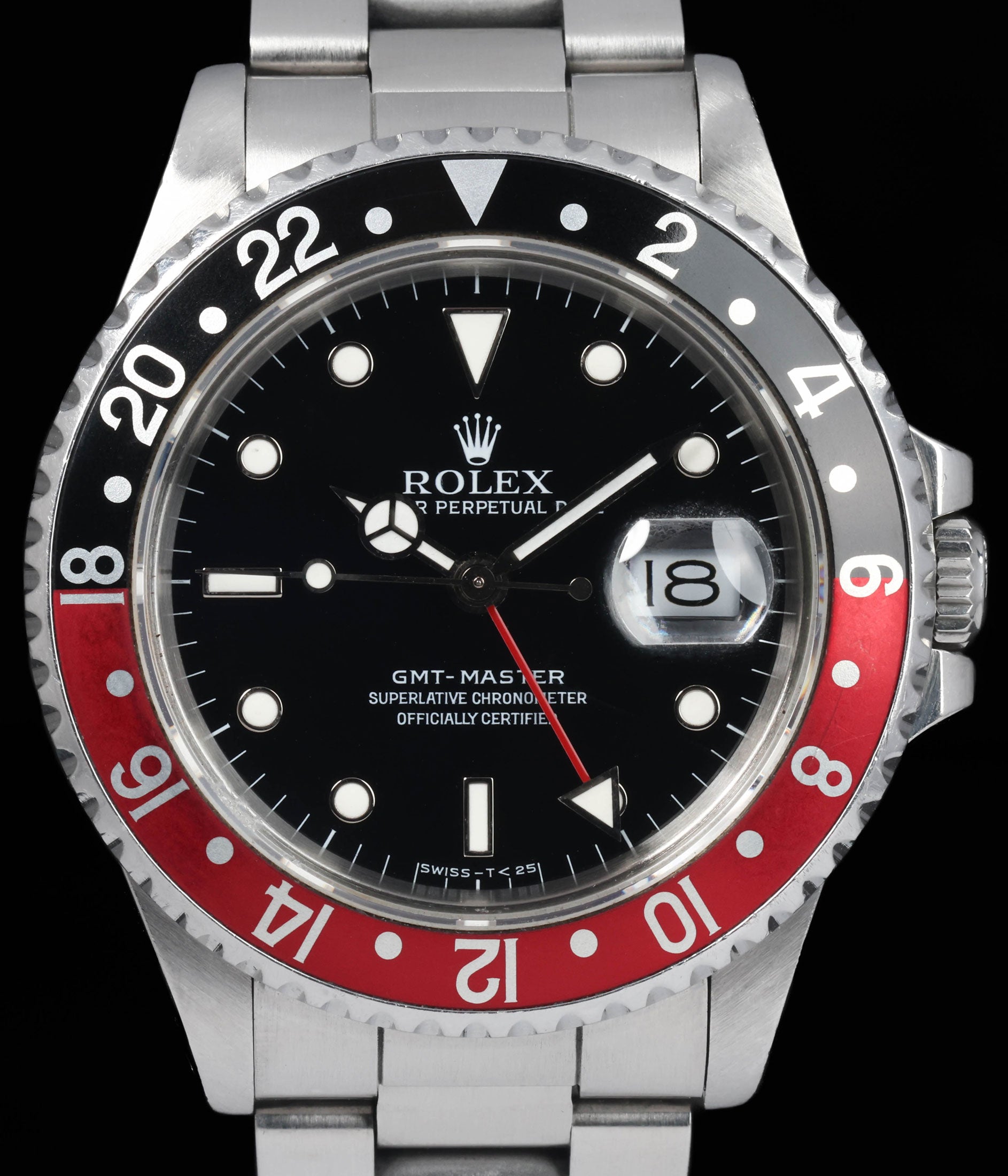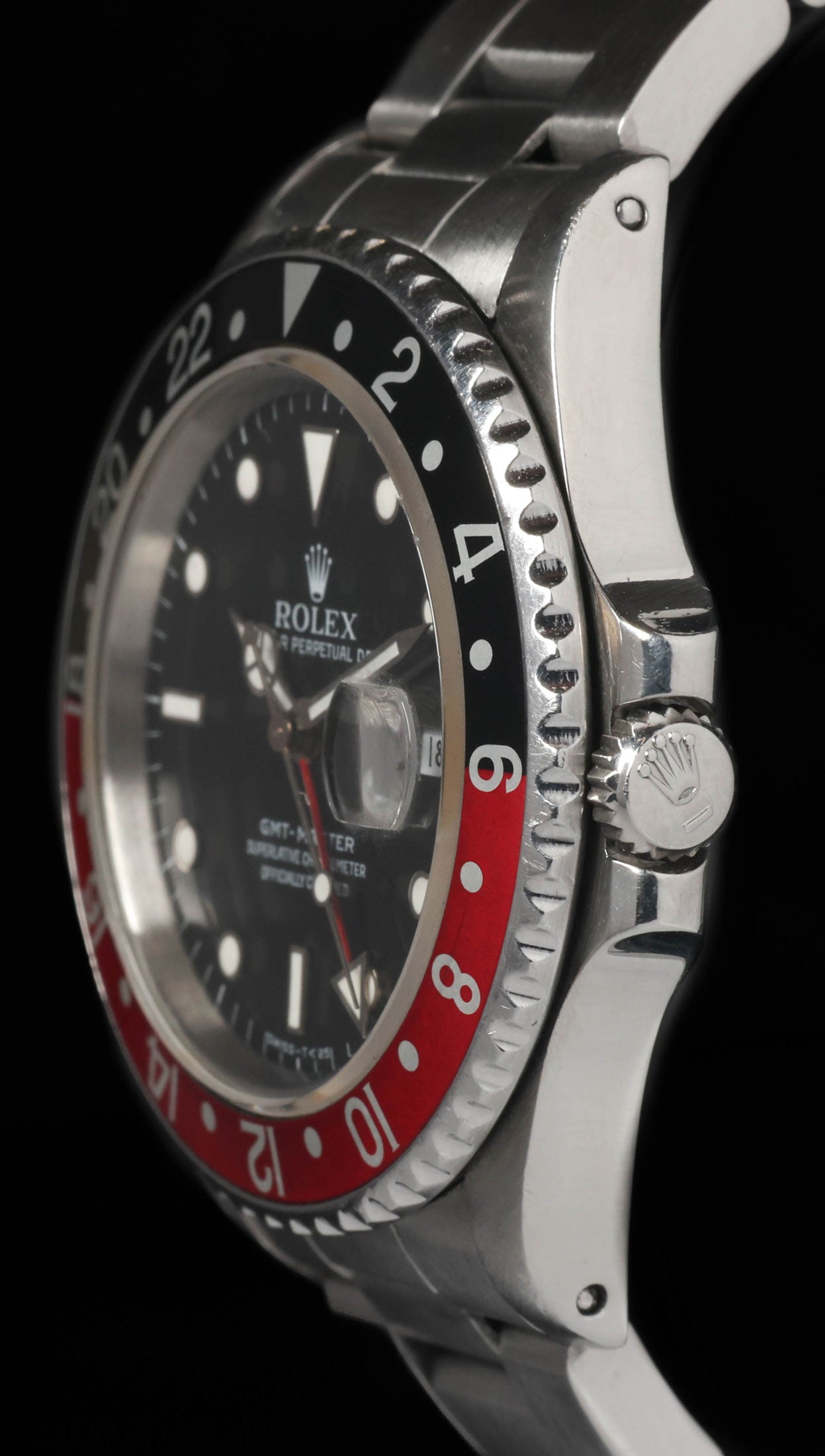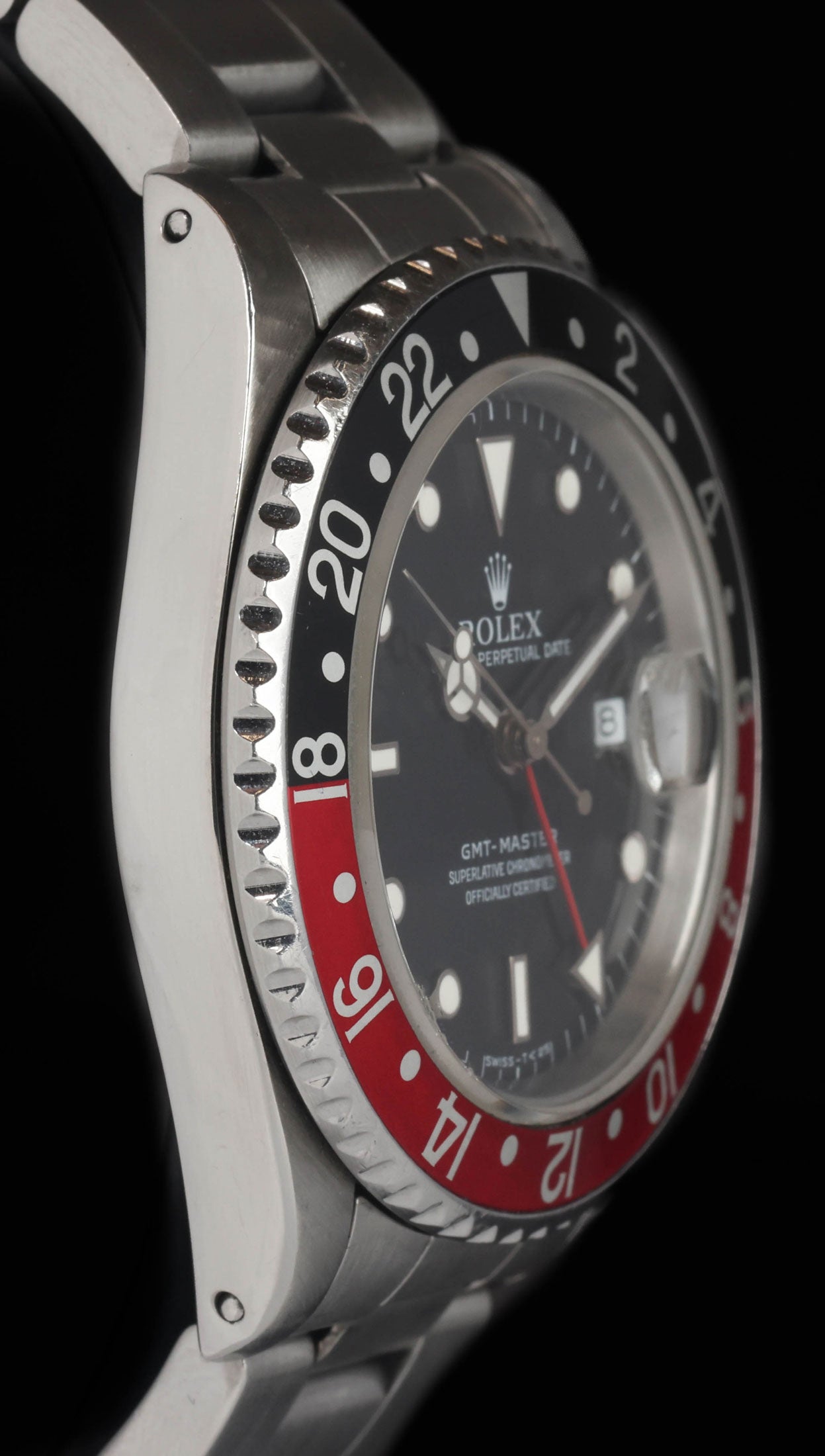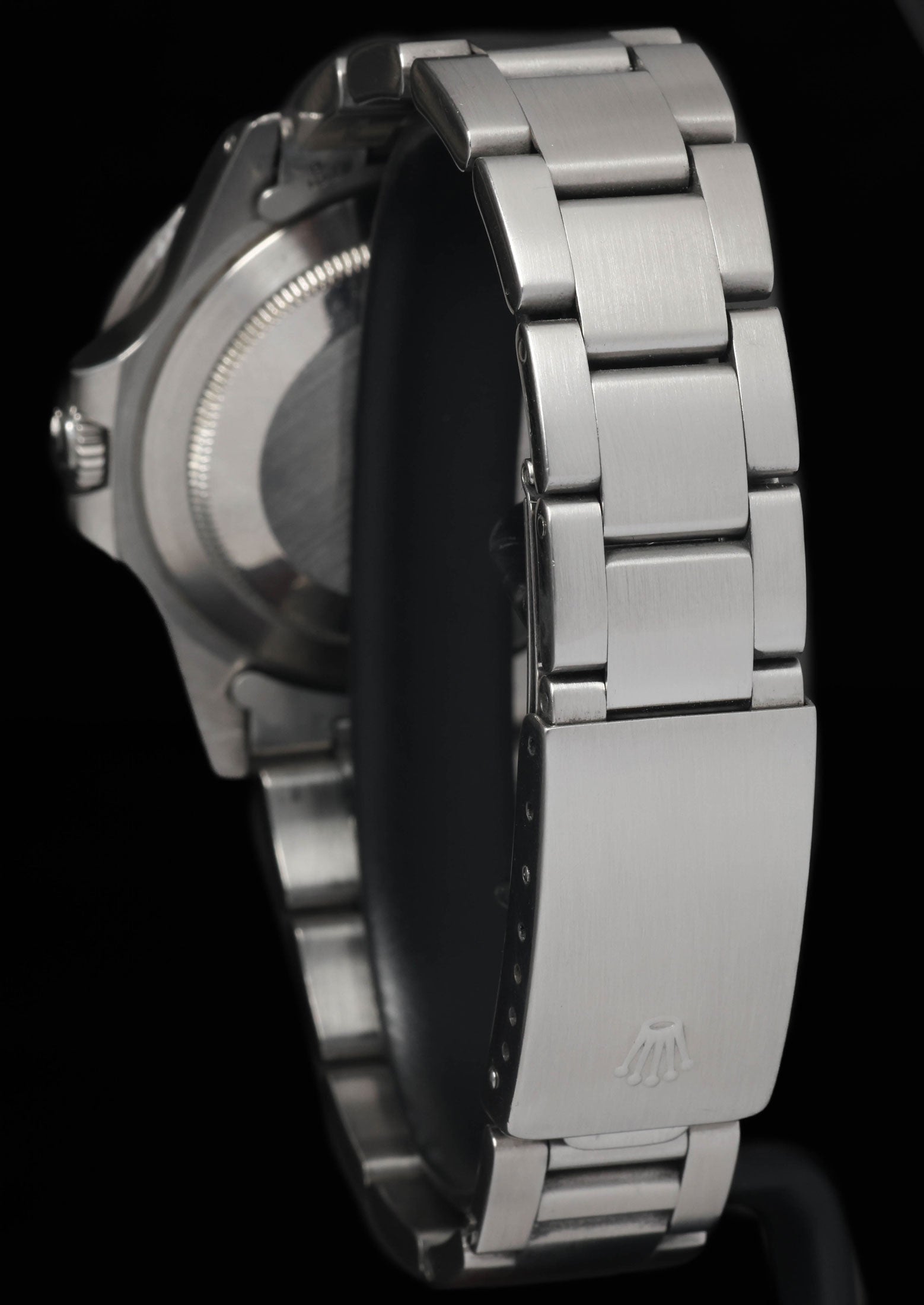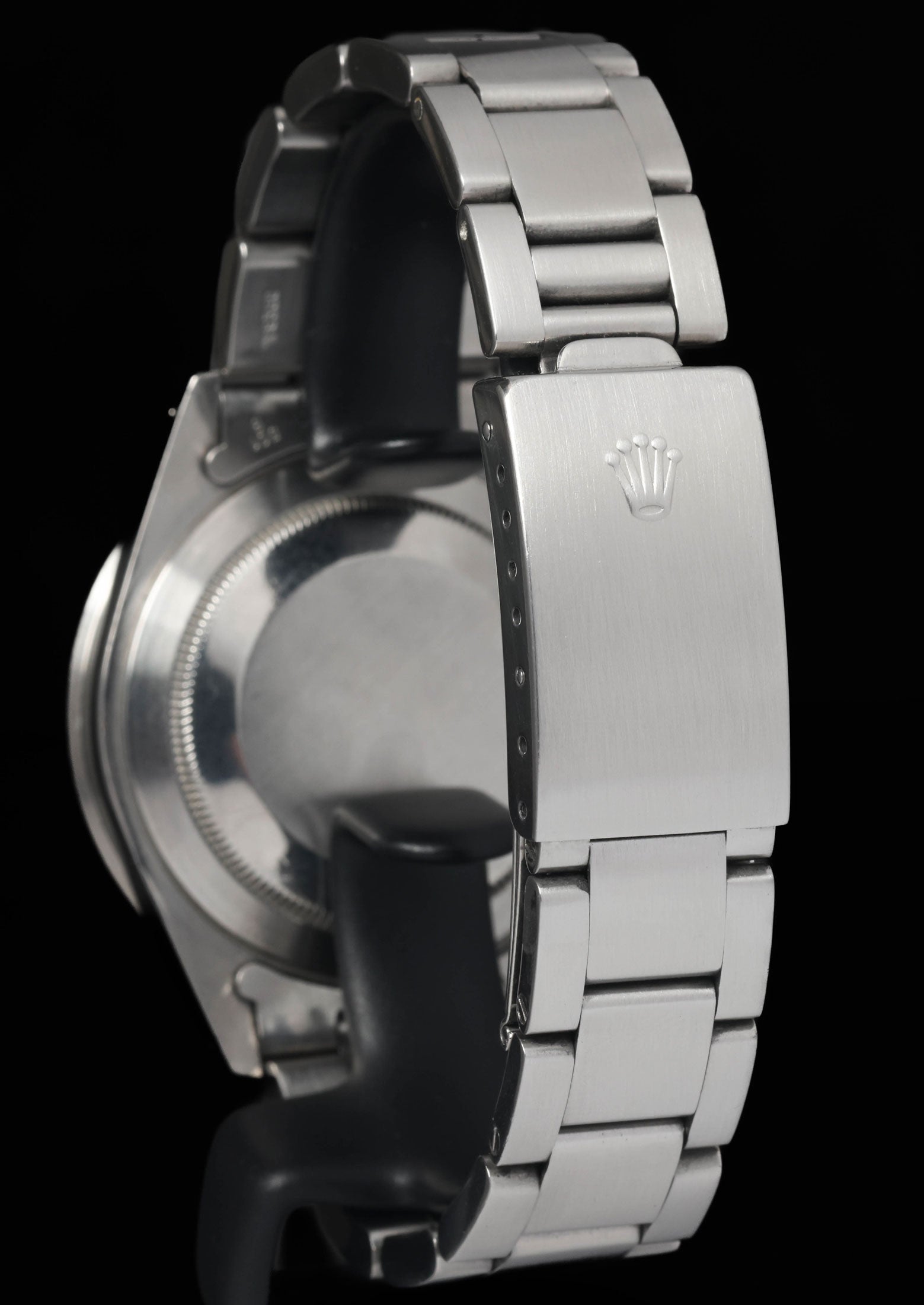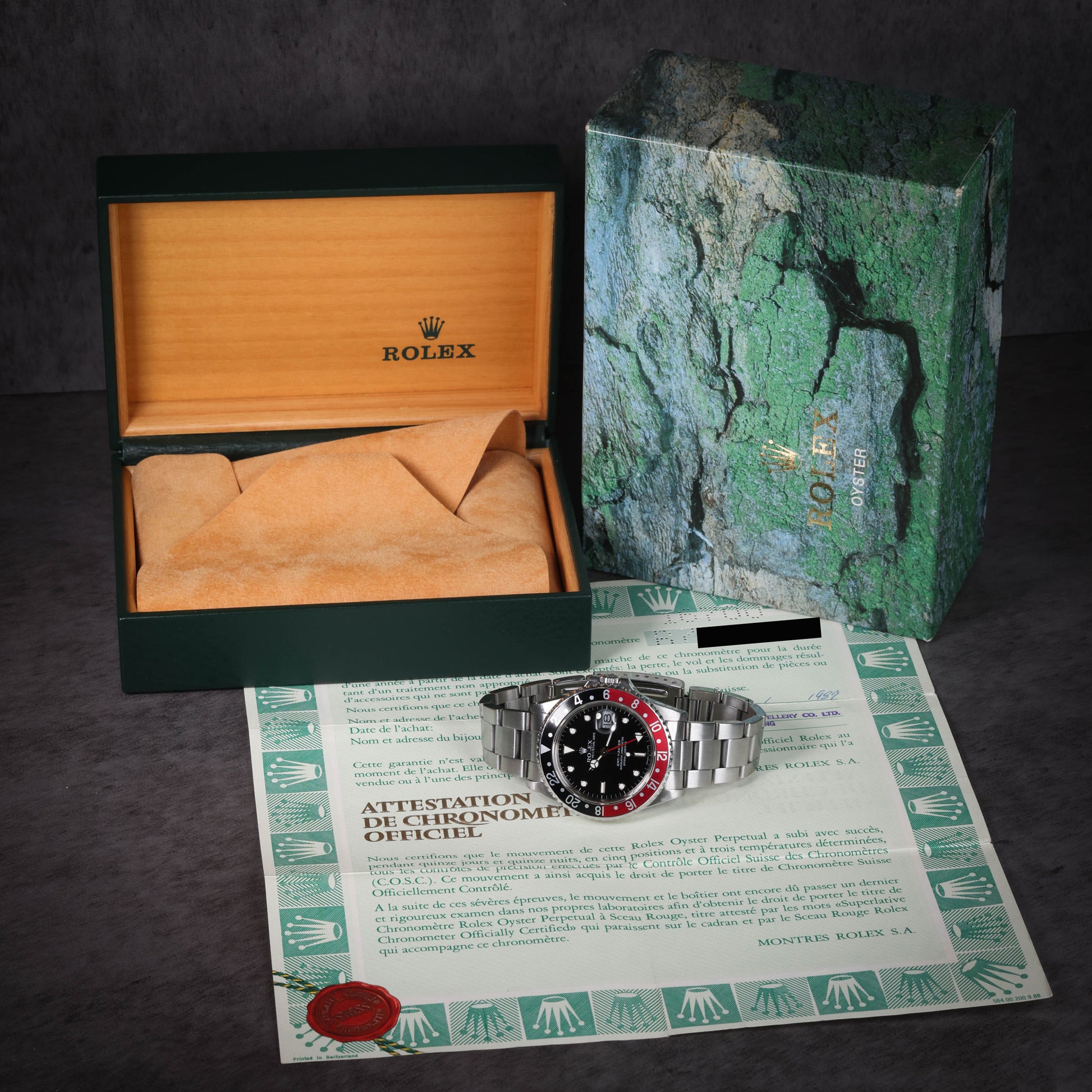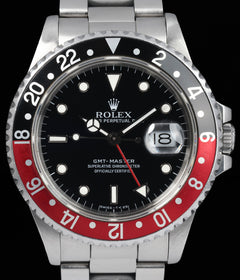Crown Vintage
Rolex GMT Master 16700 40mm 1988 Box & Papers
Rolex GMT Master 16700 40mm 1988 Box & Papers
Couldn't load pickup availability
Rolex GMT Master 16700 40mm 1988
The stainless steel Oyster case presents in great condition, with light hairlines visible on both sides from careful use. The case has received a light polish prior to our acquisition, with surfaces retaining sharp definition and correct proportions. Bezel and lugs remain clean, showing only minimal signs of wear.
The matching Oyster bracelet is also in great condition, with only minimal stretch noticeable and light surface marks consistent with honest wear. Clasp action remains crisp and secure.
The glossy black dial and luminous-filled hands are in very good condition, with crisp printing and no blemishes visible. The watch features the desirable “open 6” datewheel, further enhancing its period correctness.
This example is accompanied by its original box and papers, adding to its completeness and appeal. Overall, a strong representation of the reference, combining a clean case and bracelet, attractive dial and hands, and full set presentation.
Share
Why we love this watch
Why we love this watch
Rolex GMT-Master 16700
Introduction
When Rolex unveiled the GMT-Master reference 16700 in the late 1980s, it represented both continuity and transition. On one hand, it carried forward the familiar design language of the GMT line, a watch that had defined dual-time-zone functionality since the 1950s. On the other hand, the 16700 marked the final chapter of the original GMT-Master line, standing alongside and eventually giving way to the GMT-Master II references.
Produced from 1988 until 1999, the GMT-Master 16700 was the last of its kind: a single time-zone model with a fixed 24-hour hand, bridging the classic simplicity of earlier references with the technical innovation of the GMT-Master II. Today, it occupies an important position in Rolex history as both a practical travel watch and a marker of the brand’s steady evolution.
The GMT-Master Story
The GMT-Master began in 1954 with the reference 6542, developed for Pan Am pilots as commercial aviation entered the jet age. The idea was straightforward: equip pilots with a wristwatch that could track both local and home (GMT) time simultaneously. By using a fourth hand rotating once every 24 hours, and pairing it with a bi-colour rotating bezel, Rolex created an intuitive solution.
The 6542 was replaced in 1959 by the reference 1675, which introduced crown guards and an increased case size. It remained in production for over two decades, becoming a cornerstone of Rolex’s professional line. Following it were the transitional references 16750 and 16753, which brought higher-beat calibres and quickset date functions.
By the late 1980s, Rolex introduced two distinct paths: the GMT-Master 16700 and the GMT-Master II 16760 (nicknamed the “Fat Lady”). The former maintained the traditional GMT-Master setup, while the latter introduced the independently adjustable hour hand that would become the hallmark of the GMT-Master II series.
The Case
The 16700 carried the familiar 40mm Oyster case in stainless steel, waterproof to 100 metres thanks to its screw-down Triplock crown and robust case construction. The proportions echoed those of the 16750, but with subtle refinements to finishing and geometry that reflected Rolex’s incremental design philosophy.
The lugs featured brushed tops with polished sides, striking a balance between tool-watch utility and understated elegance. The bezel was bidirectional, fitted with an aluminium insert in either the iconic red-and-blue “Pepsi” configuration or all-black for a more understated look.
While modern Rolex cases have become chunkier with broader lugs, the 16700 retained the slim and balanced profile that many consider quintessential vintage Rolex design.
The Bezel
The aluminium bezel insert of the 16700 was both functional and emblematic. The two-tone Pepsi version, with red for daytime hours and blue for nighttime, is one of the most recognisable bezels in watchmaking. For those preferring a quieter aesthetic, Rolex also offered an all-black insert, giving the watch a more subtle appearance.
Unlike the GMT-Master II, where the independently adjustable hour hand allows quick changes of local time, the 16700’s 24-hour hand was fixed to the main hour hand. To track a second time zone, the wearer rotated the bezel to align with the 24-hour hand. This meant the 16700 retained the simplicity of the original 6542 and 1675 concept.
Over time, many bezels on surviving examples have faded, with the reds softening to pinks and the blues turning sky-like. These natural changes have only added to the charm and individuality of each watch.
The Dial
The dial of the 16700 reflected Rolex’s late 1980s and 1990s design aesthetic. Early examples featured tritium lume, with the “SWISS – T<25” signature at six o’clock. By the mid-1990s, Rolex transitioned to LumiNova and later Super-LumiNova, with dials marked “SWISS” or “SWISS MADE.” This progression makes the 16700 one of the last Rolex models to span the tritium-to-LumiNova transition.
The dial itself was glossy black with applied white gold surrounds for the hour markers. The 24-hour GMT hand, typically finished with a red shaft and luminous triangle, stood out clearly against the dark dial. Hands were polished and filled with matching luminous material.
This design struck a perfect balance: legibility, elegance, and the unmistakable Rolex professional tool-watch look.
The Bracelet
The 16700 was available on both the Oyster and Jubilee bracelets, each 20mm wide at the lugs.
- Oyster bracelet (ref. 78360 or later solid-link 78790): Three-piece links, brushed outer and polished sides, sporty and robust.
- Jubilee bracelet (ref. 62510H): Five-piece links, dressier and more supple on the wrist, a nod to Rolex’s dual nature as both a tool and luxury brand.
The Oysterlock clasp featured a flip-lock safety mechanism, ensuring security during active wear. The versatility of bracelet choice allowed wearers to tailor the watch to either professional or everyday contexts.
The Movement: Calibre 3175
The GMT-Master 16700 was powered by the Rolex calibre 3175, introduced in 1988. This automatic movement was part of Rolex’s 3000 series, robust and reliable, with a 28,800 vibrations per hour beat rate and hacking seconds for precise time-setting.
Key features included:
- 31 jewels.
- 42-hour power reserve.
- Quickset date function.
- Fixed 24-hour hand.
The quickset date was a significant convenience, allowing the wearer to adjust the date independently via the crown. However, unlike the GMT-Master II’s calibre 3085 and later 3185, the 3175 did not allow independent adjustment of the local hour hand. This was the key mechanical distinction that set the 16700 apart as the final GMT-Master, rather than a GMT-Master II.
The GMT-Master vs GMT-Master II Split
When the 16700 was introduced, Rolex also launched the GMT-Master II 16760. This marked the first time Rolex ran two separate GMT references simultaneously.
The 16700 offered the classic simplicity of the original design, appealing to those who valued tradition and ease of use. It was also slightly less expensive than the GMT-Master II, positioning it as an entry point into the line.
The GMT-Master II, by contrast, represented the future: with its independently adjustable hour hand, it allowed tracking of three time zones and greater convenience for frequent travellers. Over time, the GMT-Master II became the dominant model, and the 16700 was phased out in 1999.
The Significance of the 16700
The 16700 holds an important place in Rolex’s history. It represents the end of the original GMT-Master lineage, closing a chapter that began with the 6542 in 1954. Its production run of just over a decade was relatively short compared to the decades-long run of the 1675, making it less common than some other references.
It also straddled two eras of Rolex production: the tritium lume of earlier models and the LumiNova era of the modern brand. This makes it particularly interesting for those studying the evolution of Rolex dial materials and design.
Wearability and Presence
On the wrist, the 16700 feels quintessentially Rolex. Its 40mm case size is timeless, sitting comfortably on a wide range of wrists. The slim profile and balanced proportions make it versatile enough for both casual and formal wear.
The Pepsi bezel adds a splash of colour and unmistakable identity, while the all-black version offers understated refinement. With either bracelet option, the 16700 retains the dual character that has always defined the GMT-Master: both professional tool and stylish accessory.
The Broader GMT-Master Legacy
The GMT-Master line is one of Rolex’s most iconic, alongside the Submariner and Daytona. It reflects the spirit of global travel and professional utility, connecting directly to the mid-20th-century boom in aviation.
The 16700, though often overshadowed by the GMT-Master II, is vital to this story. It preserved the original concept of a dual-time-zone watch that required bezel interaction, linking back to the 6542 and 1675. It also provided a more accessible alternative to the GMT-Master II during its production years, ensuring continuity for Rolex’s loyal clientele.
Transition of Materials and Technology
One of the underappreciated aspects of the 16700 is its role in Rolex’s material and technology transition during the late 20th century.
- Lume: The shift from tritium to LumiNova occurred during the 16700’s production run. Early examples with creamy, aged tritium offer vintage character, while later ones with LumiNova provide modern functionality.
- Bracelets: Early folded-link Oyster bracelets gave way to solid-link construction, reflecting Rolex’s move toward greater robustness.
- Crystal: Sapphire crystal was standard, offering superior scratch resistance compared to the acrylic crystals of earlier models.
These changes position the 16700 at a crossroads between vintage charm and modern durability.
Conclusion
With its 40mm Oyster case, aluminium Pepsi or black bezel, calibre 3175 movement, and choice of Oyster or Jubilee bracelet, the 16700 embodies both the tradition and the evolution of the GMT line. Its role as a transitional model, spanning the move from tritium to LumiNova and from GMT-Master to GMT-Master II, gives it historical weight far beyond its production numbers. On the wrist, the 16700 remains as versatile and appealing as ever.
Case & Bracelet
Case & Bracelet
- Case & bracelet in great condition, light hairlines visible on both sides.
- Bracelet in great condition, minimal stretch noticeable.
- Case has received a light polish (prior to us acquiring)
- Watch also features open 6 datewheel.
Dial & Hands
Dial & Hands
Dial & hands in very good condition.
Warranty & Condition
Warranty & Condition
Crown Vintage Watches provides a minimum 3-month mechanical warranty on pre-owned watches, from the date of purchase.
The warranty covers mechanical defects only.
The warranty does not cover damages such as scratches, finish, crystals, glass, straps (leather, fabric or rubber damage due to wear and tear), damage resulting from wear under conditions exceeding the watch manufacturer’s water resistance limitations, and damage due to physical and or accidental abuse.
Please note, water resistance is neither tested nor guaranteed.
Shipping and insurance costs for warranty returns to us must be covered by the customer. Returns must be shipped via traceable courier. Return shipment must be pre-paid and fully insured. Collect shipping will be refused. In case of loss or damages, the customer is liable.
Our Pledge
At Crown Vintage Watches, we stand by the authenticity of every product we sell. For added peace of mind, customers are welcome to have items independently authenticated at their own expense.
Condition
Due to the nature of vintage timepieces, all watches are sold as is. We will accurately describe the current condition and working order of all watches we sell to the best of our ability.
Shipping & Refund
Shipping & Refund
